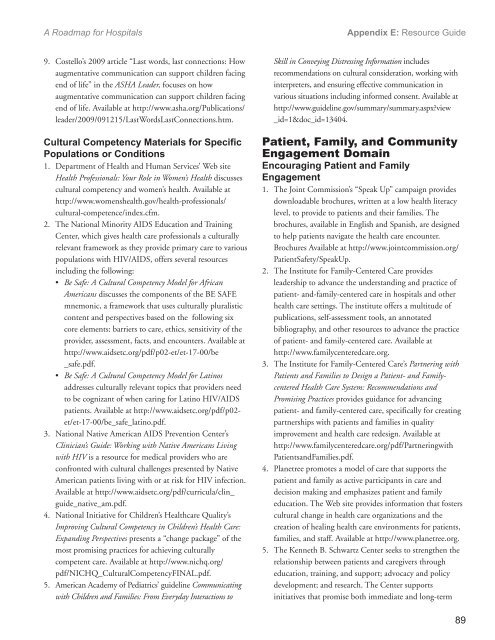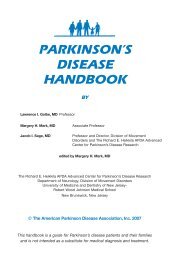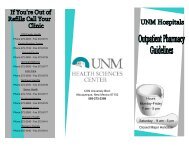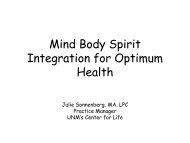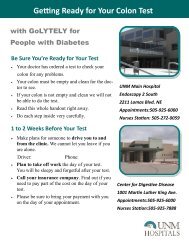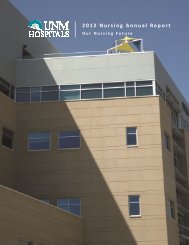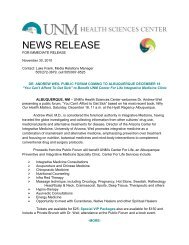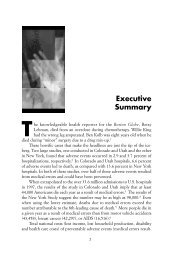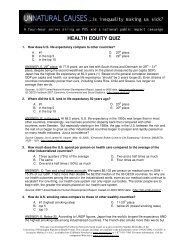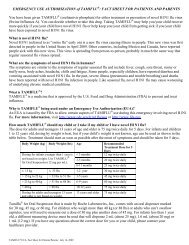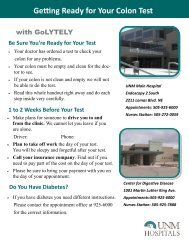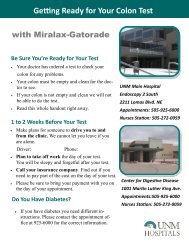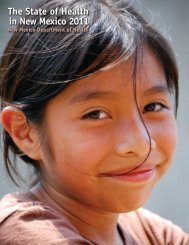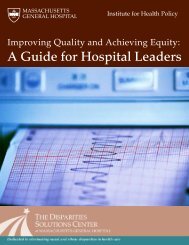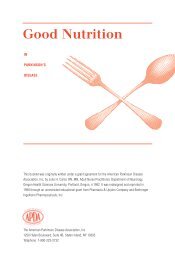Advanced Effective Communication, Cultural Competence, and ...
Advanced Effective Communication, Cultural Competence, and ...
Advanced Effective Communication, Cultural Competence, and ...
Create successful ePaper yourself
Turn your PDF publications into a flip-book with our unique Google optimized e-Paper software.
A Roadmap for Hospitals<br />
Appendix E: Resource Guide<br />
9. Costello’s 2009 article “Last words, last connections: How<br />
augmentative communication can support children facing<br />
end of life” in the ASHA Leader, focuses on how<br />
augmentative communication can support children facing<br />
end of life. Available at http://www.asha.org/Publications/<br />
leader/2009/091215/LastWordsLastConnections.htm.<br />
<strong>Cultural</strong> Competency Materials for Specific<br />
Populations or Conditions<br />
1. Department of Health <strong>and</strong> Human Services’ Web site<br />
Health Professionals: Your Role in Women’s Health discusses<br />
cultural competency <strong>and</strong> women’s health. Available at<br />
http://www.womenshealth.gov/health-professionals/<br />
cultural-competence/index.cfm.<br />
2. The National Minority AIDS Education <strong>and</strong> Training<br />
Center, which gives health care professionals a culturally<br />
relevant framework as they provide primary care to various<br />
populations with HIV/AIDS, offers several resources<br />
including the following:<br />
• Be Safe: A <strong>Cultural</strong> Competency Model for African<br />
Americans discusses the components of the BE SAFE<br />
mnemonic, a framework that uses culturally pluralistic<br />
content <strong>and</strong> perspectives based on the following six<br />
core elements: barriers to care, ethics, sensitivity of the<br />
provider, assessment, facts, <strong>and</strong> encounters. Available at<br />
http://www.aidsetc.org/pdf/p02-et/et-17-00/be<br />
_safe.pdf.<br />
• Be Safe: A <strong>Cultural</strong> Competency Model for Latinos<br />
addresses culturally relevant topics that providers need<br />
to be cognizant of when caring for Latino HIV/AIDS<br />
patients. Available at http://www.aidsetc.org/pdf/p02-<br />
et/et-17-00/be_safe_latino.pdf.<br />
3. National Native American AIDS Prevention Center’s<br />
Clinician’s Guide: Working with Native Americans Living<br />
with HIV is a resource for medical providers who are<br />
confronted with cultural challenges presented by Native<br />
American patients living with or at risk for HIV infection.<br />
Available at http://www.aidsetc.org/pdf/curricula/clin_<br />
guide_native_am.pdf.<br />
4. National Initiative for Children’s Healthcare Quality’s<br />
Improving <strong>Cultural</strong> Competency in Children’s Health Care:<br />
Exp<strong>and</strong>ing Perspectives presents a “change package” of the<br />
most promising practices for achieving culturally<br />
competent care. Available at http://www.nichq.org/<br />
pdf/NICHQ_<strong>Cultural</strong>CompetencyFINAL.pdf.<br />
5. American Academy of Pediatrics’ guideline Communicating<br />
with Children <strong>and</strong> Families: From Everyday Interactions to<br />
Skill in Conveying Distressing Information includes<br />
recommendations on cultural consideration, working with<br />
interpreters, <strong>and</strong> ensuring effective communication in<br />
various situations including informed consent. Available at<br />
http://www.guideline.gov/summary/summary.aspx?view<br />
_id=1&doc_id=13404.<br />
Patient, Family, <strong>and</strong> Community<br />
Engagement Domain<br />
Encouraging Patient <strong>and</strong> Family<br />
Engagement<br />
1. The Joint Commission’s “Speak Up” campaign provides<br />
downloadable brochures, written at a low health literacy<br />
level, to provide to patients <strong>and</strong> their families. The<br />
brochures, available in English <strong>and</strong> Spanish, are designed<br />
to help patients navigate the health care encounter.<br />
Brochures Available at http://www.jointcommission.org/<br />
PatientSafety/SpeakUp.<br />
2. The Institute for Family-Centered Care provides<br />
leadership to advance the underst<strong>and</strong>ing <strong>and</strong> practice of<br />
patient- <strong>and</strong>-family-centered care in hospitals <strong>and</strong> other<br />
health care settings. The institute offers a multitude of<br />
publications, self-assessment tools, an annotated<br />
bibliography, <strong>and</strong> other resources to advance the practice<br />
of patient- <strong>and</strong> family-centered care. Available at<br />
http://www.familycenteredcare.org.<br />
3. The Institute for Family-Centered Care’s Partnering with<br />
Patients <strong>and</strong> Families to Design a Patient- <strong>and</strong> Familycentered<br />
Health Care System: Recommendations <strong>and</strong><br />
Promising Practices provides guidance for advancing<br />
patient- <strong>and</strong> family-centered care, specifically for creating<br />
partnerships with patients <strong>and</strong> families in quality<br />
improvement <strong>and</strong> health care redesign. Available at<br />
http://www.familycenteredcare.org/pdf/Partneringwith<br />
Patients<strong>and</strong>Families.pdf.<br />
4. Planetree promotes a model of care that supports the<br />
patient <strong>and</strong> family as active participants in care <strong>and</strong><br />
decision making <strong>and</strong> emphasizes patient <strong>and</strong> family<br />
education. The Web site provides information that fosters<br />
cultural change in health care organizations <strong>and</strong> the<br />
creation of healing health care environments for patients,<br />
families, <strong>and</strong> staff. Available at http://www.planetree.org.<br />
5. The Kenneth B. Schwartz Center seeks to strengthen the<br />
relationship between patients <strong>and</strong> caregivers through<br />
education, training, <strong>and</strong> support; advocacy <strong>and</strong> policy<br />
development; <strong>and</strong> research. The Center supports<br />
initiatives that promise both immediate <strong>and</strong> long-term<br />
89


